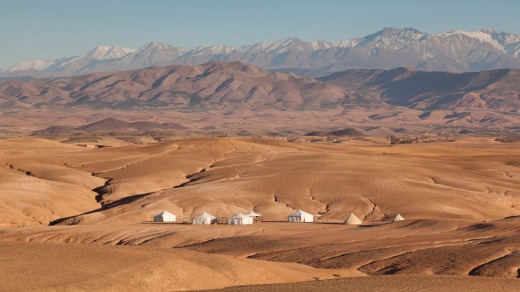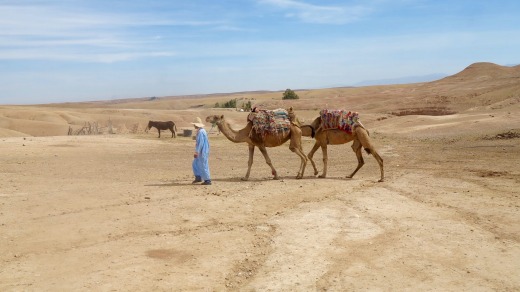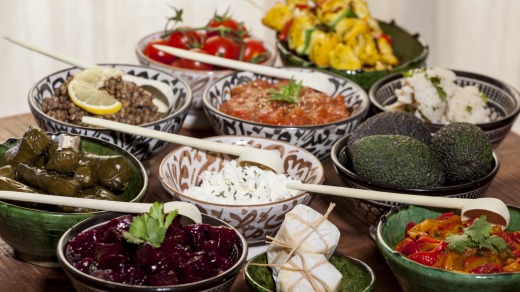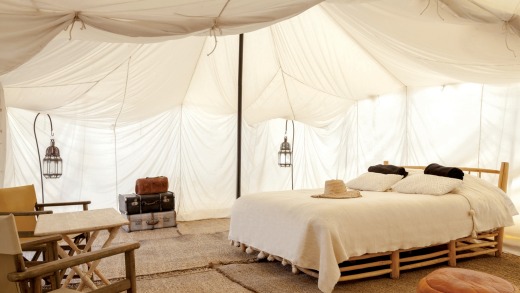Just outside of Marrakesh, Nina Karnikowski explores a Bedouin lifestyle with a difference - from mint tea and camels to Moroccan sunsets and 'desert' dwelling.
I've been in Marrakech's Agafay Desert for only 20 minutes when I discover the startling truth: I am not, in fact, in a real desert at all.
It's a perplexing revelation, seeing as I'm surrounded by nothing but biscuit-coloured mounds of rumpled rock that stretch as far as the eye can see; that over there is a lone palm tree waving its fronds at me; that right this moment I'm sitting in a Bedouin-style tent at a luxury bivouac named Scarabeo Camp. It all seems typically desert to me. And yet here the owner, a charming Belgian fellow named Vincent – his desert boot (notice his choice of footwear) crossed over his denim-clad thigh, telling me that the rolling stone desert of Agafay is not the true desert at all.
"No no," he says when I attempt to protest. "The real Sahara Desert is very far away. The one with the sand dunes? That desert you must travel another eight hours south to see."

Well, potato potahto, I think as my travel companion and I are shown to our luxury glamping tents, two of 10 set up in the nomadic encampment. I'm on a tight schedule, so this camp being just 45 minutes' drive from Marrakech suits me just fine.
As does this room. This room! To call it a tent would be an insult. Rush mats cover the ground, the wooden double bed covered in a thick Moroccan wool blanket is surrounded by artfully stacked vintage suitcases, iron lanterns suspended on posts, leather pouffes, an antique globe and a silver Moroccan tea table – all of which gives an old-school safari vibe.
Around the "corner" (aka a white sheet dividing the room) is the bathroom: an ingenious set-up comprising a handheld cold shower (there's hot water on demand), a small mirror and vanity beneath which sits a hammered silver urn to wash hands and brush teeth, and a small flushing loo. The space has been meticulously designed and is perfectly in keeping with the stark aesthetics of the Agafay and no wonder; in another life T'Sas worked as a photographer and his wife, Florence Mottet, who runs the camp with him, was a graphic designer.

But the real beauty of Scarabeo Camp lies in its surroundings, those gravelly dust-swathed expanses stretching out into oblivion, and beyond them the snow-capped peaks of the Atlas Mountains, barely a shadow in today's harsh afternoon light. In summer, T'Sas and Mottet pack up their tents and relocate to a shadier spot half a dozen kilometres away, although I can't imagine anywhere being a more perfect location for a deluxe camp than the sparsely vegetated, sunbeaten flat we're sitting on right now. We stay right there, sipping our way through a pot of hot, sweet mint tea for a good half hour, then decide there's nothing for it but to indulge our Lawrence of Arabia fantasies by throwing on a kaftan and headscarf and heading out into the wilderness.
We wander into the afternoon heat, gravel crunching underfoot as we twist downward into a series of ravines. It's only when I start trying to climb back up again in my leather sandals that I realise deserts – even fake deserts – require desert footwear. So while my companion scales the mountain ahead of us with the speed and skill of Edmund Hillary, I sit at the base and I wait.
Eventually, a local farmer rides up on a donkey and stops for a chat (OK, a laugh at my ridiculously large earrings) before he trots off into the sunset and we trot back to camp, not wanting to miss what we know is going to be a spectacular show.

And my goodness, it is. Sitting on bleached wood low couches strewn with sandy yellow cushions, a glass of cold Casablanca beer in hand, we watch the bright blue sky become streaked with fairy floss clouds, which before long are replaced with stars that pop out like gooseflesh in the heavens. Just when we think it couldn't get any better, we turn around to find that the entire camp has been lit up by dozens of flickering lanterns.
The ridiculousness continues as we're ushered over to the dining tent, which is basically an oversized, open-sided version of our sleeping tents. The wooden dining table is set with candelabra, there's traditional Tuareg music playing quietly, it's incredibly romantic.
Delivered to our table are spicy eggplant, tomato and carrot salads, followed by a trio of tagines: lemon chicken, beef with stewed dates and apricots, fragrant potato and bean, all accompanied by a light Moroccan cabernet sauvignon and a dessert of sticky orange tart.

Bellies full to bursting and merry with wine, we waddle out to the pair of hammocks perched on the edge of camp and gaze up the star-studded sky that feels so big it might suck us right out of our hammocks. In the face of this grandeur we can't help but get philosophical, wondering how we can hold onto the idea that we're at the centre of the universe when this majestic nothingness lies before us.
Travelling out into nowhere like this – even if it's just the edge of nowhere – is a reminder of our true position in the scheme of things, an acknowledgement of our smallness. We resist the temptation to fall asleep right there under the big yellow moon, but only just.
The next morning I'm up with the sun, taking 15 minutes to sit in the small shaded wooden deck in front of my tent and simply stare out over the stark landscape. Before long, and after a lazy Moroccan breakfast, we're exploring that nothingness once again.
Luckily, this time we're prepared with appropriate footwear and a beautiful half-Berber (the indigenous people of North Africa), half-Ethiopian guide named Hafida, who has glossy coco skin, dark braided hair down to her waist and a neck full of turquoise.
"I was the first ever female mountain guide in Morocco," she says with pride as we puff our way up a steep sun-baked hill scattered with quartz crystals and the occasional black scarab beetle after which our camp is named. "There were 600 men and me!"
As we continue scampering along, trying to keep up with Hafida's impressive pace, we pass a herd of sheep and goats and a while later a Berber graveyard where the headstones remain unmarked because, as Hafida explains, "under the earth we're all the same".
But over the next three hours that's about it, aside from the relentlessly dry, brown earth.
"It's hard to imagine now, but in spring and summer this landscape is covered with wheat, barley and wildflowers," Hafida says.
Eventually we reach an oasis of palm and olive trees that marks the outskirts of our destination, the small mud hut village of Laroussiene. All is quiet in the village, save for the giggles of two small children hiding behind their mother's skirt in the doorway of one of the houses, and the clucking of a chook that's somehow escaped its mud-walled yard. Other than that it's just how you might imagine a desert village to be dusty, calm, earth cracked like a broken plate, enormous cacti shooting up out of the earth. Like something out of the Old Testament.
Our ride back to camp is also rather Old Testament: a couple of sleepy camels piled high with colourful Moroccan blankets, led by a thin local man wearing a long blue robe, the traditional dress of the Berber men. It's not the most comfortable ride in the world, but it's the quintessential Moroccan Desert experience and it sure beats walking in the 36-degree heat.
Back at camp, T'Sas is waiting for us. He immediately leads us to a table filled with white bowls brimming with spiced Moroccan salads and msemen, a fried Moroccan flatbread, which we devour while sipping chilled glasses of rose and daydreaming about all the things we might have done had we had more time. We might have booked in for a private yoga session or massage for the afternoon. We might have rented a mountain bike or dune buggy – although to break the silence out here would seem almost sacrilegious. And if we'd been organised, says T'Sas, we might even have nabbed ourselves a hot-air balloon ride.
Alas, the chaos and colour of Marrakech calls and it's time to leave our desert hideaway.
A little while later, when T'Sas walks us and our bags to our car, he drapes his arm over the open door and gazes out into the hills, nodding his head wistfully.
"Yes," he says, "This desert is small, but it's a playground."
It isn't until he's slammed the door shut and waved us goodbye that we realise what he's just admitted. Or perhaps it was just a slip of the tongue. Either way, we've decided that Scarabeo Camp and this strange, spartan landscape is just the perfect amount of desert for us.
visitmorocco.com
Emirates flies from Sydney and Melbourne to Casablanca via Dubai from about $1680 return, see emirates.com/au. From Casablanca, connect to Marrakech on a 55-minute Royal Air Maroc flight; see royalairmaroc.com.
Scarabeo's Stone Desert Camp runs from September 15 to June 15. Rates start at about $295 per night per double, including breakfast and dinner. Drinks and activities including camel trekking, guided hiking and mountain biking, yoga and massage come at an additional cost.
Scarabeo also runs a "Coast Camp" and mobile camps that can be set up anywhere in Morocco. See scarabeocamp.com.
By Prior Arrangement creates small bespoke luxury tours and private itineraries to Morocco based around trekking, art, architecture, gardens or food; see bypriorarrangement.com.
As old as the city itself, Marrakech's famous Jemaa el-Fna square is teeming day and night with storytellers, jugglers, snake charmers, musicians, dancers, monkey tamers, medicine men and more. A mesmerising melange of sights, smells and sounds that's perhaps best seen from above at Cafe Glacier.
As beguiling as they are beautiful, the tight knot of Marrakech's souks that wind through the ancient medina is almost impossible to manage without a helping hand. Inside you'll find a convoluted maze of stalls selling everything from Moroccan wool blankets, filigree iron lanterns and leather babouche slippers, to glittering silk kaftans, bottles of spices and tribal jewellery.
For peace and quiet head to the Majorelle Garden, privately owned by the estate of fashion designer Yves Saint Laurent and created in the 1930s by French artist Jacques Majorelle. Wander through bamboo and cactus groves, past towering palms and reflection pools, and those infamous midnight-blue urns and the artist's former studio. Don't miss the Berber museum's stunning collection of antique jewellery. Rue Yves Saint Laurent; see jardinmajorelle.com.
Dating back to the mid-1500s, the sultan Ahmed al-Mansour spared no expense on his tomb, importing Italian Carrara marble and gilding the plasterwork with pure gold. Here you'll see the interments of about 60 members of the Saadi Dynasty.
After a day of sightseeing, a traditional hammam spa will no doubt be in order. La Sultana hotel and La Maison Arabe offer some of the best (read: smartest and most glam) experiences in the city, that are worth splashing out for. See lasultanahotels.com; lamaisonarabe.com.